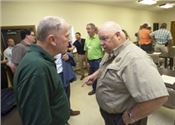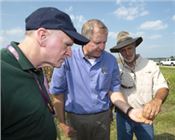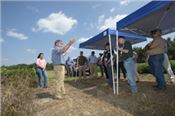|
U.S. Department Of Agriculture Officials Visit LSU AgCenter

Louisiana agriculture commissioner Mike Strain, right, talks to Kevin Shea, administrator of the U.S. Department of Agriculture Animal and Plant Health Inspection Service, before a meeting at the Lois Caffey Termite Training Center on the LSU AgCenter Central Research Station in
Baton Rouge on Aug. 23, 2018.
Photo by Olivia McClure/LSU AgCenter
BATON ROUGE, LA.
Several U.S. Department of Agriculture officials toured an LSU AgCenter research station and met with Louisiana agriculture leaders, researchers and farmers on Aug. 23.
The group heard about ways the AgCenter and the Louisiana Department of Agriculture and Forestry work together to help farmers keep invasive pests at bay and avoid spreading them. They also visited the Louis Dreyfus Company grain elevator at the Port of Greater Baton Rouge, where Louisiana commodities such as soybeans are loaded onto ships for international sales.
The USDA delegation was led by Kevin Shea, administrator of the Animal and Plant Health Inspection Service, who works in Washington, D.C. Others who attended included Mike Gregoire, APHIS associate administrator; Osama El-Lissy, APHIS Plant Protection and Quarantine deputy administrator; and several USDA program directors.
State agriculture commissioner Mike Strain and U.S. Rep. Garret Graves also were at the meeting.
“Foreign insects and diseases wreak damage that can render crops unmarketable, and it’s our job to work with states and industry to help prevent their introduction and spread,” Shea said. “If farmers aren’t profitable in agriculture, they can’t feed the world, clothe the world.”
LSU Vice President for Agriculture Bill Richardson welcomed the visitors as they arrived at the AgCenter Central Research Station in Baton Rouge.
“You’re going to see some good things today,” he said. “We’re glad to have you here.”
Two farmers and a slate of AgCenter scientists told the delegation about practices they use to reduce weed populations and limit the amount of weed seed in harvested soybeans.
“Although the United States produces high-quality and safe grains, the presence of weed seeds in international shipments is a concern and may contribute to trade barriers,” said Rogers Leonard, an AgCenter associate vice president who oversees animal, plant and water programs. “We have to ensure that we are doing all we can to prevent that.”
The issue is especially important for Louisiana, he said.
“The Mississippi River ports of south Louisiana facilitate over 60 percent of the nation’s grain exports,” Leonard said. “We are fortunate that USDA APHIS had the opportunity to visit a Louisiana port and have open discussions with our scientists and representatives of Louisiana agriculture. Soybeans are a major field crop in our state, and in 2017, soybeans were planted on over 1.25 million acres by 2,346 producers.”
Shea applauded the pest management work of the AgCenter and other university institutions.
“We in APHIS understand … that our relationship with the state and, by extension, state universities and producers is key,” he said. “We can’t do anything alone.”
“We stand with you,” he added.
Strain pointed to two invasive pests recently found in Louisiana – the guava root-knot nematode and the Phragmites scale – as top concerns. While the nematode so far has been contained to one field in the state, the scale insect has caused extensive damage by feeding on a coastal plant called Roseau cane.
“We’re seeing plant pests and diseases a latitude higher than they used to be,” Strain said. “It seems like we’re fighting things we never had to fight before.”
Teamwork among his department, the AgCenter and federal agencies such as the USDA helps protect Louisiana’s $13 billion agriculture industry from those pests, he said.
“Invasive species and foreign animal diseases are something we take very, very seriously,” he said. ∆

Kevin Shea, left, administrator of the U.S. Department of Agriculture Animal and Plant Health Inspection Service, looks on as LSU AgCenter associate vice president Rogers Leonard, center, and Melville, Louisiana, farmer Charles Cannatella, right, hold soybean seeds during a tour at the AgCenter Central Research Station in Baton Rouge on Aug. 23, 2018.
Photo by Olivia McClure/LSU AgCenter

LSU AgCenter weed scientists Lauren Lazaro, left, and Daniel Stephenson, second from left, talk about their research during a field tour at the AgCenter Central Research Station in Baton Rouge that was attended by state and federal agriculture officials on Aug. 23, 2018.
Photo by Olivia McClure/LSU AgCenter
|
|